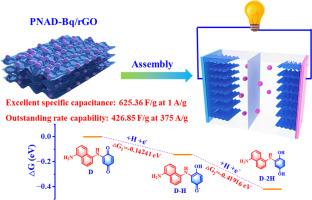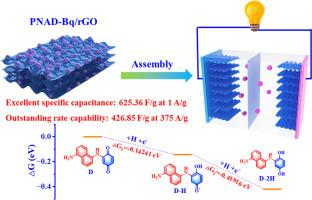Incorporation of conjugated quinone-amine polymer with rGO via strong π-π interaction for enhanced electrochemical performance
IF 5.6
3区 材料科学
Q1 ELECTROCHEMISTRY
引用次数: 0
Abstract
Quinone-based polymers, characterized by reversible electron transfer enabled by a polyketone structure, have emerged as promising candidates for high-performance supercapacitors (SCs) electrodes due to their inherent pseudo-capacitive behavior. However, their practical application is often constrained by poor conductivity and stability. Herein, we introduce an innovative approach by integrating a quinone-amine polymer (PNAD-Bq), synthesized from 1,5-naphthalenediamine and 1,4-benzoquinone, with reduced graphene oxide (rGO) through one-step hydrothermal method. The π-π conjugation between PNAD-Bq and rGO effectively prevents graphene sheets aggregation, enhancing pseudo-capacitance, electron transport, and ion migration. The optimized PNAD-Bq/rGO exhibits outstanding electrochemical performance, achieving a high specific capacitance of 625.36 F/g at 1 A/g, an exceptional rate capability of 63.85 % even up to extremely high current density of 375 A/g, and remarkable cycling stability, retaining 71.56 % of its initial specific capacitance after 50,000 cycles at 100 mV/s. When employed in symmetric SCs, the PNAD-Bq/rGO delivers a specific capacitance of 534.67 F/g at 0.1 A/g and maintains remarkable cycle stability of 73.1 % after 50,000 cycles at 1 A/g. This work highlights the potential of quinone-based polymers composite electrode material as a high-performance electrode material, providing a promising pathway for the construction of high-performance electrode materials.


通过强π-π相互作用将共轭醌-胺聚合物与氧化石墨烯结合以增强电化学性能
醌基聚合物的特点是通过聚酮结构实现可逆电子转移,由于其固有的伪电容性,醌基聚合物已成为高性能超级电容器(SCs)电极的有希望的候选者。然而,它们的实际应用往往受到导电性和稳定性差的限制。本文介绍了一种创新的方法,通过一步水热法将1,5-萘二胺和1,4-苯醌合成的醌-胺聚合物(pad - bq)与还原氧化石墨烯(rGO)结合。pad - bq和rGO之间的π-π共轭有效地阻止了石墨烯片的聚集,增强了伪电容、电子传递和离子迁移。优化后的pad - bq /rGO具有优异的电化学性能,在1 a /g电流下可达到625.36 F/g的高比电容,在高达375 a /g的极高电流密度下仍能保持63.85%的倍率能力,在100 mV/s电流下循环5万次后仍能保持71.56%的初始比电容。当用于对称sc时,pad - bq /rGO在0.1 a /g下提供534.67 F/g的比电容,并且在1 a /g下循环50,000次后保持73.1%的显着循环稳定性。本研究突出了醌基聚合物复合电极材料作为高性能电极材料的潜力,为高性能电极材料的构建提供了一条有前景的途径。
本文章由计算机程序翻译,如有差异,请以英文原文为准。
求助全文
约1分钟内获得全文
求助全文
来源期刊

Electrochimica Acta
工程技术-电化学
CiteScore
11.30
自引率
6.10%
发文量
1634
审稿时长
41 days
期刊介绍:
Electrochimica Acta is an international journal. It is intended for the publication of both original work and reviews in the field of electrochemistry. Electrochemistry should be interpreted to mean any of the research fields covered by the Divisions of the International Society of Electrochemistry listed below, as well as emerging scientific domains covered by ISE New Topics Committee.
 求助内容:
求助内容: 应助结果提醒方式:
应助结果提醒方式:


